So, how do you tell the difference between auriculatus and angustidens? If your answer involves a ouija board, then you're not alone. So many amatuer and professional paleoichthyologists have pondered the issue that its surprising that a definitive answer has not yet arisen. Actually, its not that surprising after all. The two species weren't separated by that much geologic time, they were directly related, they lived in the similar locations, they ate similar prey, and they grew to similar sizes. Some people even think there is no difference and that they should be the same species. I am not one of those people, however, and this is my attempt to share my thoughts on the how to tell the difference.
Location
Let's say you're in the Jelly Belly store (Jelly Beans, for those of you who don't have one close by) and you want to get some caramel apple flavored jelly beans. The great thing about the Jelly Belly store is they conveniently sort them out for you. All you have to do is look on the front of the jar, and it tells you exactly what flavor is contained therein. Alternately, you can go over to the jar of mystery. This is where all the jelly beans are mixed together and you can't tell what flavor they are. You can pull out one that looks like a caramel apple jelly bean, but it could also be a vomit flavored one (they seriously have those!). I'm sure you can see where I'm taking this analogy. The only way you can be 100% sure a particular tooth is an auriculatus or an angustidens is if you know its origin. Furthermore, the location must only produce one species or the other. Since we don't often collect in a lab, this is seldom possible. We must rely on tooth features to make the determination in most cases. There are, however, a few locations where both of the aforementioned conditions are true. The Lafarge quarry in Harleyville, SC is an Eocene site that produces auriculatis teeth from a pristine layer called the green cap. There never have been nor will there ever will be angustidens teeth found at this location, so I will use specimens from here to exemplify auriculatis. Likewise, "The Big Ditch" in Summerville, SC is an Oligocene site that produces angustidens teeth from a pristine layer called the Chandler Bridge. Angustidens and not auriculatus teeth are found here so I will use this location to exemplify the oligocene species in question.
Root
Most often, the distinguishing factor between angustidens and auriculatatis is the root. Refer to figure 1.
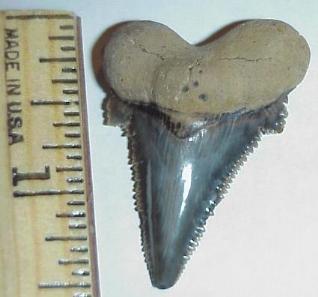 |
| lateral auriculatus specimen from Lafarge quarry collected by the author. | |
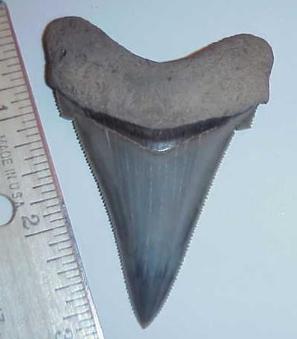 |
| lateral angustidens specimen from a Berkeley County, SC ditch with exposed Chandler Bridge collected by the author. | |
| Figure 1. Root differences between angustidens and auriculatus. |
Notice first the root lobes on the auriculatus. Both lobes are very rounded, almost circular in appearance. As a "ric" tooth's distance from the sympheseal line increases, it is not uncommon for the lobe adjacent to the distal edge to become more angular. However, the lobe adjacent to the mesial edge usually maintains its rounded appearance. Compare this to the angustidens. The ends of the lobes seem to be the apex of an angle formed between the centerline of the root and the root/blade boundary even at the lateral positions. As the "angy" increases in distance from the sympheseal joint, the root lobe adjacent to the distal edge becomes distinctly angular. Another feature that seems to be distinctly angustidens is the tendency of the root to "recurve". Notice the concave features just above where the root meets the blade. A final distinguishing feature is the presence of "ears". Notice on the angustidens the presence of the root structures that extend over the outside edge of the cusps. This trait is also shared by a species down the evolutionary chain, megalodon. Another distinguishing root characteristic is the tendency for auriculatus teeth to rest upright on their roots. This is undoubtedly due to the more robust nature of "ric" roots. Refer to figure 2.
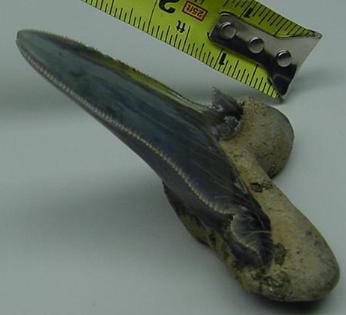 |
| Figure 2. auriculatus specimen from the Lafarge quarry collected by da f0ssZ. Notice how it rests unaided on the root. |
Cusps
The simple presence of cusps at all always seemed to be a freakish occurrence to me. They seem to serve no purpose except to make the teeth look cool! If you buy into the evolution theory, then nature decided that they were worthless, too. Ever see an megalodon teeth with big cusps hanging off the edge? Whatever their purpose, the cusps serve as another way to distinguish auriculatus from angustidens. Refer to figure 3. On the left is a closeup of the cusp of an angustidens, and on the right is a closeup of the cusp of an auriculatus. Notice how the separation between cusp and blade is more pronounced in the auriculatus example. The cusp is more "independent" of the blade than the cusp on the angustidens, which shares more enamel at its inner base. I have seen specimens of auriculatus where the cusps are completely separated from the blade. In some angustidens, the blade and cusps seem to "fold" together.
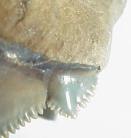 |
| closeup of an angustidens cusp. | |
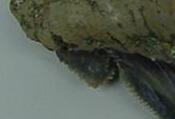 |
| closeup of an auriculatus cusp. | |
| Figure 3. Cusps differences between angustidens and auriculatus. |
None of these observations is intended to be the "be all, end all" in species determination. Specimens undoubtedly exhist that do not conform to these traits. These are mainly traits common to most specimens. So the main point is, if you know exactly where the tooth in question came from and teeth from only one of the two species are found there, then you have your answer. If not, check the root. Round root lobes or the ability of the tooth to rest on the root supporting the weight of the blade suggests auriculatus. Next, look closely at the cusps. If the separation between cusp and blade is pronounced, the specimen is likely an auriculatus. The situation becomes even more hairy when the possibility of chubutensis is thrown into the mix. But that's beyond the scope of this little pseudo-article, isn't it?